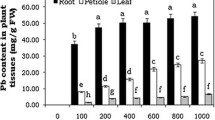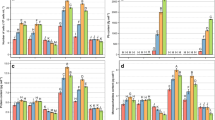Abstract
This study hypothesized that the positive or negative effects of exogenous abscisic acid (ABA) on oxidative stress caused by lead were dose dependent. The effects of different levels of ABA (2.5, 5, and 10 mg L−1) on lead toxicity in the leaves of Atractylodes macrocephala were studied by investigating plant growth, soluble sugars, proteins, lipid peroxidation, and antioxidative enzymes. Excess Pb inhibited root dry weight, root length, and the number of lateral roots, but increased shoot growth. In addition, lead stress significantly decreased the levels of chlorophyll pigments, protein, and activities of superoxide dismutase (SOD), catalase (CAT), ascorbate peroxidase (APX), and peroxidase (POD). Different levels of ABA significantly increased SOD, CAT, POD, and APX activities, but decreased the level of hydrogen peroxide and malondialdehyde in nonstressed plants. Exogenous application of 2.5 mg L−1 ABA detoxified the stress-generated damages caused by Pb and also enhanced plant growth, soluble sugars, proteins, and all four antioxidant enzyme activities but reduced Pb uptake of lead-stressed plant compared to lead treatment alone. However, the toxic effects of Pb were further increased by the applications of 5 and 10 mg L−1 ABA. The levels of antioxidants caused by a low concentration of exogenous ABA might be responsible for minimizing the Pb-induced toxicity in A. macrocephala.









Similar content being viewed by others
References
Aebi H (1984) Catalase in vitro. Methods Enzymol 105:121–126
Agarwal S, Sairam RK, Srivastava GC, Meena RC (2005) Changes in antioxidant enzymes activity and oxidative stress by abscisic acid and salicylic acid in wheat genotypes. Biol Plant 49:541–550
Arnon DI (1949) Copper enzyme in isolated chloroplast polyphenoloxidase in Beta vulgaris. Plant Physiol 24:1–15
Beffa R, Martin HV, Pilet PE (1990) In vitro oxidation of indoleacetic acid by soluble auxin-oxidases and peroxidases from maize root. Plant Physiol 94:485–491
Bradford MM (1976) A rapid and sensitive method for the quantitation of microgram quantities of protein utilizing the principle of protein-dye binding. Analytical Biochem 72:248–254
Chen HM (2004) Soil science of environment. Science Press, Beijing, pp 548–549, in Chinese
Chen G, Shi Q, Lips SH, Sagi M (2003) Comparison of growth of flacca and wild-type tomato grown under conditions diminishing their differences in stomatal control. Plant Sci 164:753–757
Chen CW, Yang YW, Lur HS, Tsai YG, Chang MC (2006) A novel function of abscisic acid in the regulation of rice root growth and development. Plant Cell Physiol 47:1–13
Chow PS, Landhäusser SM (2004) A method for routine measurements of total sugar and starch content in woody plant tissues. Tree Physiol 24:1129–1136
Eun S, Youn HS, Lee Y (2000) Lead disturbs microtubule organization in the root meristem of Zea mays. Physiol Plant 110:357–365
Finkelstein RR, Gampala SS, Rock CD (2002) Abscisic acid signaling in seeds and seedlings. Plant Cell 14(Suppl):S15–S45
Gajewska E, Sklodowska M, Slaba M, Mazur J (2006) Effect of nickel on antioxidative enzyme activities, proline and chlorophyll contents in wheat shoots. Biol Plantarum 50:653–659
Giannopolitis CN, Ries SK (1977) Superoxide dismutase in higher plants. Plant Physiol 59:309–314
Gong M, Li YJ, Chen SZ (1998) Abscisic acid-induced thermotolerance in maize seedlings is mediated by calcium and associated with antioxidant systems. J Plant Physiol 153:488–496
Heath RL, Packer L (1968) Photoperoxidation in isolated chloroplasts. I. Kinetics and stoichiometry of fatty acid peroxidation. Arch Biochem Biophys 125:189–198
Hertwig B, Streb P, Feieraband J (1992) Light dependence of catalase synthesis and degradation in leaves and the influence of interfering stress conditions. Plant Physiol 100:1547–1553
Hsu YT, Kao CH (2003) Role of abscisic acid in cadmium tolerance of rice (Oryza sativa L.) seedlings. Plant Cell Environ 26:867–874
Jiang MY, Zhang JH (2001) Effect of abscisic acid on active oxygen species, antioxidative defence system and oxidative damage in leaves of maize seedlings. Plant Cell Physiol 42:1265–1273
Jiang MY, Zhang JH (2002) Role of abscisic acid in water stress-induced antioxidant defense in leaves of maize seedlings. Free Radic Res 36:1001–1015
Joseph L, Uveges CAL, Mal TK (2002) Effects of lead contamination on the growth of Lythrum salicaria (purple loosestrife). Environ Pollut 120:319–323
Li CY, Yin CY, Liu SR (2004) Different responses of two contrasting Populus davidiana populations to exogenous abscisic acid application. Environ Exp Bot 51:237–246
Li Z, Zhao X, Sandhu AK, Gu LW (2010) Effects of exogenous abscisic acid on yield, antioxidant capacities, and phytochemical contents of greenhouse grown lettuces. J Agric Food Chem 58:6503–6509
Nakano Y, Asada K (1981) Hydrogen peroxide is scavenged by ascorbate-specific peroxidase in spinach chloroplasts. Plant Cell Physiol 22:867–880
Qureshi MI, Abdin MZ, Qadir S, Iqbal M (2007) Lead-induced oxidative stress and metabolic alterations in Cassia angustifolia Vahl. Biol Plant 51:121–128
Rucińska R, Gwóźdź EA (2005) Influence of lead on membrane permeability and lipoxygenase activity in lupine roots. Biol Plantarum 49:617–619
Shu X, Yin LY, Zhang QF, Wang WB (2012) Effect of Pb toxicity on leaf growth, antioxidant enzyme activities, and photosynthesis in cuttings and seedlings of Jatropha curcas L. Environ Sci Pollut Res 19:893–902
Siedlecka A, Tukendorf A, Skórzyńska-Polit E, Maksymiec W, Wójcik M, Baszyński T, Krupa Z (2001) Angiosperms. In: Prasad MNV (ed) Metals in the environment. Analysis by biodiversity. Marcel Dekker, New York, pp 171–217
Strubinskai J, Hanaka A (2011) Adventitious root system reduces lead uptake and oxidative stress in sunflower seedlings. Biol Plantarum 55:771–774
Velikova V, Yordanov I, Edreva A (2000) Oxidative stress and some antioxidant systems in acid rain-treated bean plants. Protective role of exogenous polyamines. Plant Sci 151:59–66
Verma S, Dubey RS (2003) Lead toxicity induces lipid peroxidation and alters the activities of antioxidant enzymes in growing rice plants. Plant Sci 164:645–655
Yang L, Yu CL, Shi F, Wei YQ, Wang CC, Hu HT, Cheng CG (2007) Effects of abscisic acid on growth and dehydration tolerance of Cynanchum komarovii seedlings. Plant Growth Regul 51:177–184
Yoshida K, Igarashi E, Mukai MK, Hirata MK (2003) Induction of tolerance to oxidative stress in the green alga, Chlamydomonas reinhardtii, by abscisic acid. Plant Cell Physiol 26:451–457
Zhang FQ, Zhang HX, Wang GP, Xu LL, Shen ZG (2009) Cadmium induced accumulation of hydrogen peroxide in the leaf apoplast of Phaseolus aureus and Vicia sativa and the roles of different antioxidant enzymes. J Hazard Mater 168:76–84
Zhao L, Xiong J, Li LP, Zhu C (2009) Low concentration of exogenous abscisic acid increases lead tolerance in rice seedlings. Biol Plantarum 53:728–732
Zhou BY, Guo ZF, Lin L (2006) Effects of abscisic acid application on photosynthesis and photochemistry of Stylosanthes guianensis under chilling stress. J Plant Growth Regul 48:195–199
Acknowledgments
Financial support was provided by the Natural Science Foundation of China (31000293, 30901146) and the Open Research Fund Program of Key Lab of Eco-Environmental Science for Yellow River Delta in Universities of Shandong (Binzhou University).
Author information
Authors and Affiliations
Corresponding author
Additional information
Responsible editor: Elena Maestri
Rights and permissions
About this article
Cite this article
Wang, J., Chen, J. & Pan, K. Effect of exogenous abscisic acid on the level of antioxidants in Atractylodes macrocephala Koidz under lead stress. Environ Sci Pollut Res 20, 1441–1449 (2013). https://doi.org/10.1007/s11356-012-1048-0
Received:
Accepted:
Published:
Issue Date:
DOI: https://doi.org/10.1007/s11356-012-1048-0




